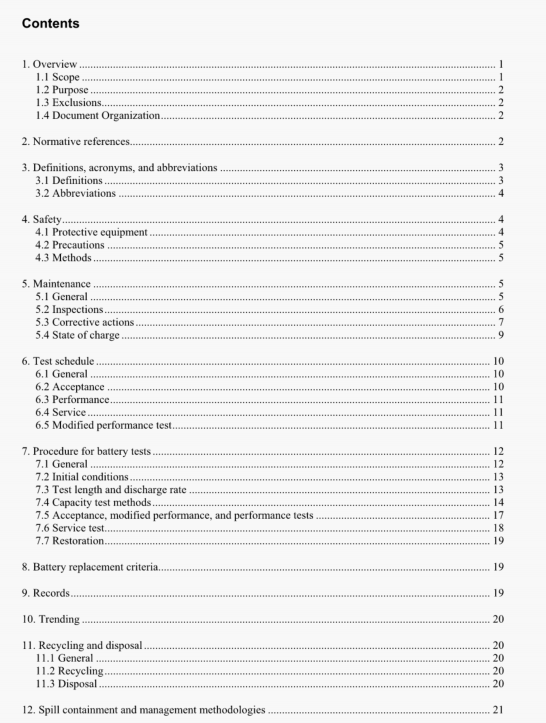IEEE 450:2010 pdf free download.IEEE Recommended Practice for Maintenance,Testing, and
Replacement of Vented Lead-Acid Batteries for Stationary Applications.
c) If resistance measurements obtained in 5.2.3, item d) or 5.3.1, item b) are more than 20% above the installation value or above a ceiling value established by the manufacturer/system designer, or if loose connections are noted, retorque and retest. If retested resistance value remains unacceptable, the connection should he disassembled, cleaned, reassembled, and retested. Refer to IEEE Std 44 for detailed procedures. See also D.2 and Annex F.
d) When cell temperatures deviate more than 3 °C from each other during a single inspection, determine the cause and correct the problem. If sufficient correction cannot be made, contact the manufacturer for allowances that must be taken.
NOTE When working with large multi-tier installations, the 3 °C allowable deviation may not be achievable. The user should contact the manufacturer for guidance.
e) When excessive dirt is noted on cells or connectors, remove it with a water-moistened clean wipe. Remove electrolyte spillage on cell covers and containers with a bicarbonate of soda solution mixed 100 grams of soda to I liter of water. Avoid the use of hydrocarbon-type cleaning agents (oil distillaics) and strong alkaline cleaning agents, which may cause containers and covers to crack or craze.
f) When the float voltage measured at the battery terminals is outside of its recommended operating range, it should be adjusted.
5.3.2 Equalizing charge
Item a) though item d) in this sub-clause indicate conditions that, if allowed to persist for extended periods. can reduce battery life. They do not necessarily indicate a loss of capacity. Therefore, the corrective action can be accomplished prior to the next quarterly inspection, provided that the battery condition is monitored at regular intervals (not to exceed one week). Note that an equalizing charge normally requires that equalizing voltage be applied continuously for 24 hours or longer. (Refer to the manufacturer’s instructions.) Single ccli charging is an acceptable method when a single ccii or a small number of cells appear to need equalizing.
a) An equalizing charge is desirable if individual cell float voltage(s) deviate from the average value by an amount greater than that recommended by the manufacturer.
b) If an undercharge condition is suspected (low individual cell voltage, plate sulfation, etc.), speciticgravity readings should be taken on the suspect cells, especially if the cells are lead-antimony type. An equalizing charge should be given if the specific gravity, corrected for temperature, of an individual cell falls below the manufacturer’s lower limit (see D.4).
c) An equalizing charge should be given immediately if any cell voltage is below the manufacturer’s recommended minimum cell voltage (see C. I).
d) Some manufacturers recommend periodic equalizing charges. This equalizing charge can be waived for certain batteries based on an analysis of the records of operation and maintenance inspections (sec 9).
5.3.3 Other abnormalities
Correct any other abnormal conditions noted. See Annex D for a more detailed discussion of these abnormalities and the urgency of the corrective actions.
IEEE 450:2010 pdf free download
